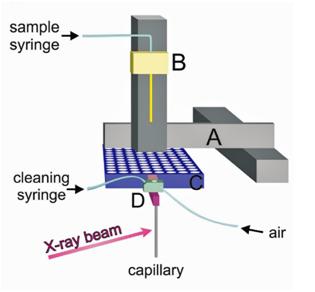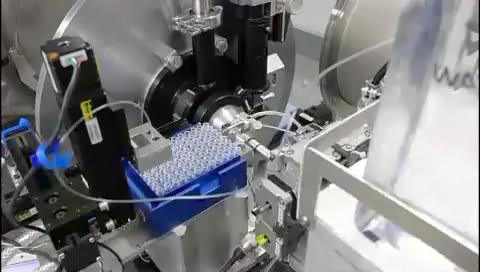Autosampler: a high-throughput automated sample changer for solution X-ray scattering
The BL4-2 Autosampler is a fully automatic sample delivery device for solution scattering experiments. It has been designed for aqueous solutions of biological samples like protein, DNA, RNA, lipid and their complexes. It is based on a standard 96-well micro plate format and currently uses VMR 0.2ml 8x PCR strip (VMR catalog number: 20170-004).
The Autosampler is fully integrated into the BluIce control system of the beamline. Together with the data reduction and analysis tools (SasTool and SAXSPipe) available at the beamline, the BL4-2 Autosampler is part of a fully integrated solution scattering pipeline.
Main features:
- Compact in-house design
- 10-30ul sample/buffer volume for a data set 1)
- better than 99% success rate (excluding human error) 2)
- Less radiation damage by oscillating sample during data collection
- Fast data collection (3-5min/set, 96 samples in 5-8 hours) 3)
- thorough cleaning of capillary, needle and tube (with user customizable cleaning procedure)
- 96-well plate format with temperature control
- 1.5mm capillary cell
- Support wide q-range (see below)
- Sample recovery after data collection (option)
- Compatible with DLS plate reader format
- in-situ fiber-optic UV/Vis spectrophotometer (option)
1) Depending on radiation damage (i.e. total dose on sample).
2) Worked with water and most common buffers. No error was observed with Glycerol up to 40%. We could optimize your unusual buffer. Please contact BL4-2 staff if you have unusual buffer.
3) Depending on data collection and washing procedure.
 |
 Click above image to view the video Click above image to view the video |
Variable setups available for larger and smaller samples
The accessible q-range of our standard setup (1.7m sample-detector distance with 11keV beam) is ~0.007 Å-1 < q < ~0.55 Å-1 (with q=4psin(q)/l, and q is half of the scattering angle), supporting most common sample sizes of Rg <~75 Å. Different sample-detector distances and beam energies are also available with Auto-sampler. See here (link) for more detail. Please contact BL4-2 staff if your sample size is relatively larger or smaller. Please note that we cannot accommodate multiple sample-detector distance within a one day experiment. If you think you will need this please contact the beam line stuff well in advance of the beam time.
Sample preparation
Sample volume and total irradiation to sample are associated with radiation damage. Our standard sample volume for Auto-sampler is currently 30ul per data set (i.e. per tube). In most case, this provides good result with typical data collection like 10-15 images with 1sec exposure. Please contact BL4-2 staff if you need to minimize sample volume.
We generally recommend taking 3-7 different concentrations of your sample in same buffer (concentration series). Concentration range is depending on sample (e.g. nucleic acid more scatters X-ray than protein) and sample size. For example, a concentration series from 0.3 to 5mg/ml or 0.5 to 10mg/ml is good for BSA (~70kDa, Rg=~35 Å), or Lysozyme (~14kDa, Rg=~14 Å), respectively. To extrapolate zero concentration curve, try to measure your sample as low as possible.
You need to aliquot buffer and sample to PCR tube. A PCR strip should be used for a concentration series and identical buffer. Buffer is always applied to the left side (position A) and other tubes are used for sample concentration series (position B-H). Depending on option of buffer data collection described below, you need more than 60ul of buffer in A. Needle height of Auto-sample is optimized for VMR 0.2ml 8x PCR strip (catalog number: 20170-004). Do NOT use different PCR tube! Please order and bring the same tube when you come to BL4-2. We generally don’t provide the PCR tube and pipet tips.
Buffer data collection option
Following 2 options for buffer data collection are available in BluIce SolSAXS tab for "AlwaysBuffer?" choice:
Yes: taking buffer data sets every time before each concentration. If you have buffer in tube position A and 4 protein concentrations in tube position B-E, you will get 8 data sets (A, B, A, C, A, D, A, E). In this case, you need 120ul (= 30ul x 4) of buffer in tube A.
No (our standard): taking buffer data sets before and after concentration series. If you have buffer in tube position A and 4 protein concentrations in tube position B-E, you will get 6 data sets (A, B, C, D, E, A). In this case, you need 60ul (= 30ul x 2) of buffer in tube A.
Customizable and powerful cleaning procedure for accurate background subtraction
Accurate background subtraction is critical for subsequent analysis. You need to shoot exactly same position of the same capillary and thus the capillary should not have any dirt like radiation-damaged sample on the wall. Auto-sampler equips Hamilton fluid dispenser for sample loading and cleaning. Detergent, bleach, and ethanol are generally used for cleaning procedure. After each data collection, all places sample passed through (capillary, needle and tube) can be perfectly washed with oscillating those solutions for next data set. Since cleaning procedure is very depending on your sample and experiment, it is also customizable by user.
Reference
Martel A, et al., An integrated high-throughput data acquisition system for biological solution X-ray scattering studies. (2012) J Synchrotron Radiat. 19(Pt 3):431-4.
|


